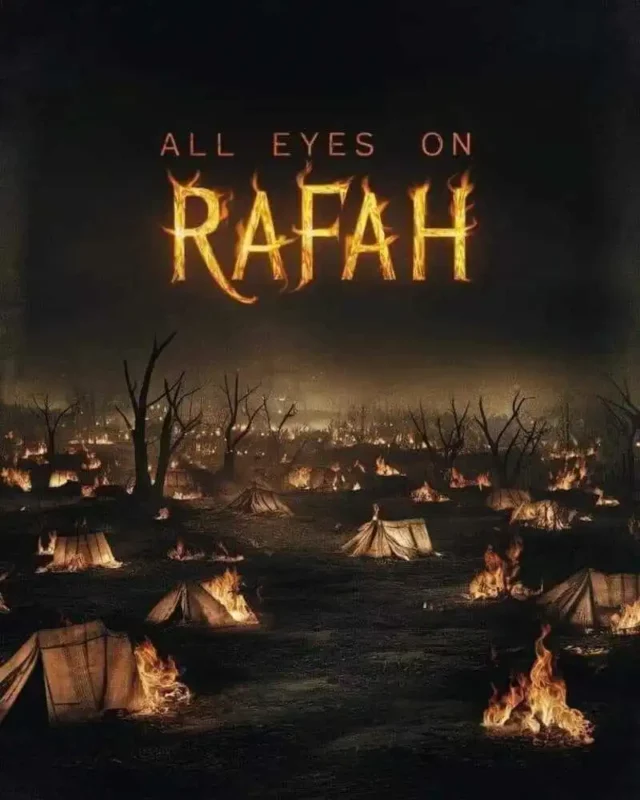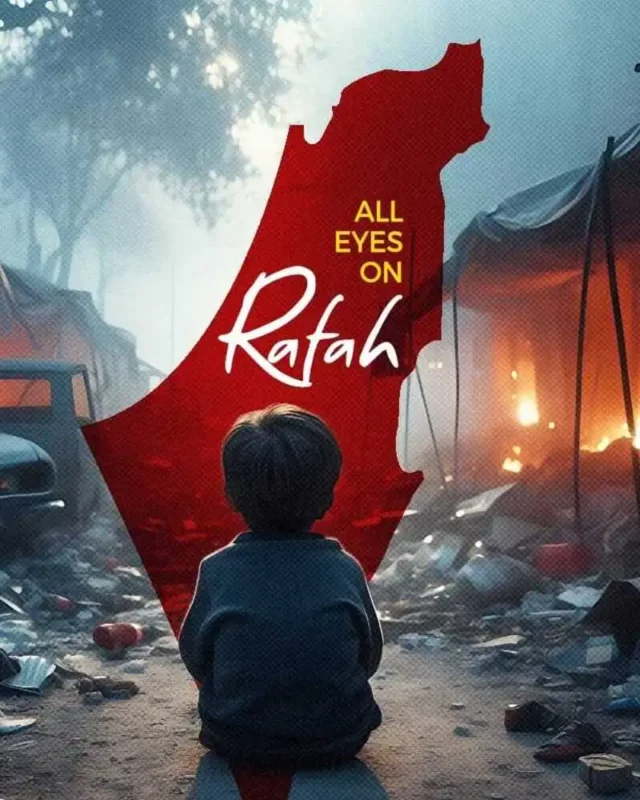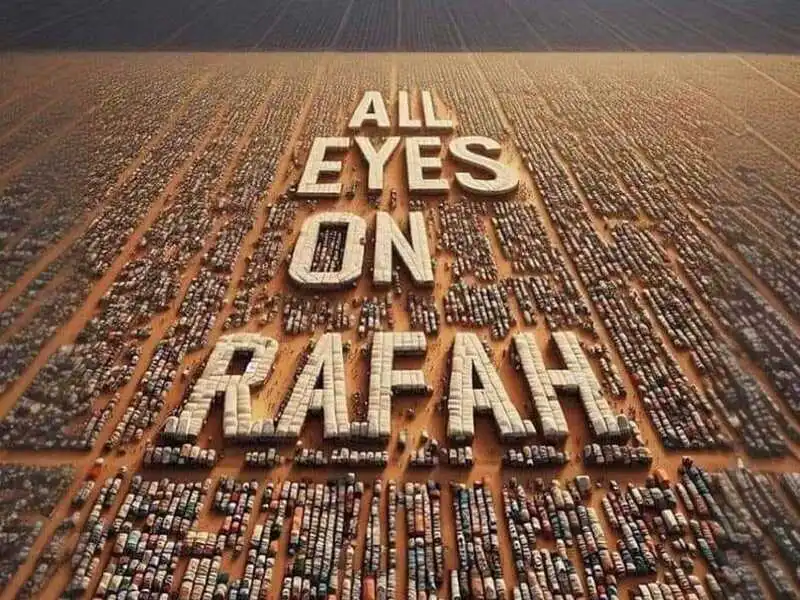The world’s watching this situation unfolding in Rafah, thanks to the ‘All Eyes on Rafah’ movement shining an enormous spotlight on everything happening in Gaza. This isn’t just a random trend; it really matters and is making people come together and notice the hard times people face because of the conflict. It’s essential to understand why everyone is noticing it so much and what this means not just for the people experiencing it but also for how countries communicate with each other, how news stations are sharing the story, and how ordinary people like you and me can do something to help: by learning why.
And because of ‘All Eyes on Rafah,’ we begin to see how far and wide its effects are spreading, from important world leaders’ talks to the signs at your local protest. And we may come up with a direct conclusion that by understanding all the different parts of ‘All Eyes on Rafah,’ we’re better equipped to figure out how to help a lot. The upshot of this entire piece is that ‘All Eyes on Rafah’ isn’t simply another story; it’s a powerful push opening eyes and minds to the real struggles in Gaza and how we, as a global community, can enter into action.
Events in Rafah and Gaza
The situation in Rafah and Gaza has grasped the world’s attention because of Israel’s latest attack: a significant amount of people had to leave their homes, and too many ended up dead. One may immerse themselves in the knowledge that When bombs started dropping in Gaza’s Rafah, many people died, and because of that, the International Court of Justice told Israel they must stop what they’re doing. We can easily see that it is obvious that this critical event made the whole world watch closely.
The upshot of this entire piece is what you might call that things have been extremely rough for the Palestinians because of all the fighting, such as bombings in al-Mawasi, people getting kicked out of their homes, and things falling from the sky, making things worse in Gaza starting October 7. It’s understood people notice how bad things are there, and it clearly shows that help needs to step in, both from peace talkers and aid givers: one, if they want, may think about just how intense things have gotten and why it’s essential to do something about it.
Every time we look at what’s happening in Rafah and Gaza, almost inevitably, we see that the violence is getting significantly worse–and making things extremely hard for ordinary people who are just trying to live their lives. These people are the ones who end up having to deal with all the awful content that comes out of conflicts and conflicts.
Now, people all around the world are paying close attention to this disaster, trying to sort out how to calm things down and make peace so no more people have to get hurt or leave their homes. One can see — and there is no doubt about it — that this situation is turning into a huge problem, with so many working to fix it without letting anyone else get caught in the middle of it all.

Image Source: Facebook
Global Attention and Social Impact
The protests in Mexico City, along with the ‘All eyes on Rafah’ event becoming viral on social media and pictures showing protests against what Israel is doing in Gaza, have made more people around the world aware of what’s happening.
There is a potential to affect how people view the events in Rafah and Gaza because of how much attention and the wide-reaching results of society have shaped the story. It may seem not very easy to believe, but we can take comfort in the fact that everyone around the world is paying attention, which makes people see things differently.
Furthermore, the reposting of these images by celebrities has amplified the message’s reach, sparking conversations and debates on various platforms.
One clearly can envision why everyone’s discussing this; the world is united in wanting peace and punishing Israel with sanctions. People keep writing about it on social media. Next, we engage in a damping study of how the internet helps get the word out about significant issues and causes them, bringing a large amount of attention to bad situations happening to people.
People are always discussing content online, and when they do, everyone worldwide listens; this changes what people think and even what happens in politics, especially about the conflicts happening in Rafah and Gaza. If they think about how sharing their thoughts can make a real difference. Thus, speaking online isn’t only for enjoyment; it can change big things.

Image Source: Facebook
Impact of ‘All Eyes on Rafah’
Everyone’s been discussing “All Eyes on Rafah” on social media, and it’s changed the conversation about what’s happening in Gaza. Now, not only people online–but also people in real life are getting together to do something about the situation. They’re in the area protesting and trying to help out because they’ve seen how bad things are for the Palestinians in Rafah. This has sparked a significant push for getting them the critical humanitarian help they need. The result is that positive effects are not only stuck on the internet but causing actual actions on the ground. And there can be gratification in knowing that all this attention is making a difference, having more people help.
Furthermore, the viral nature of this trend has spurred discussions around the ethical responsibilities of governments and international bodies in responding to the crisis in Gaza. The increased visibility of the situation in Rafah has led to calls for accountability, justice, and immediate action to alleviate the suffering of civilians caught in the crossfire.
Ultimately, ‘All Eyes on Rafah’ has served as a powerful catalyst for solidarity and activism, emphasizing the importance of standing up against injustice and promoting peace in the region.
Messaging Strategies and Advocacy
In the middle of the Gaza crisis, telling people and encouraging them to help with aid and action is really important. Not only to tell them what’s going on–but to change how they see things and sway those who make the decisions. It may have once seemed unfathomable–but messaging and people speaking up can make a significant difference in getting support where needed. The hermetic result is that we can impact what happens next by discussing it and convincing others.
In Rafah and Gaza, people are trying various ways to get their stories across with everything happening there. They’re using social media and newspapers; some are even starting street movements. They’re dead serious about ensuring that voices from the heart of the disaster are heard. Using traditional and modern methods to share information is drawing attention everywhere. There is a profound and deep-seated certainty that people in these areas want the whole world to get an honest look at what’s going on from the viewpoint of those living it. And in the final analysis, one finds that doing things in this mix-and-match style effectively rallies support.
People who like to speak up are working hard for a few things: they want the fighting to end, they’re asking for rules against Israel, and they say Palestinians need more support to show everyone how bad things are for real people; they are trying to change what everyday people, leaders, and worldwide organizations think and do about this problem getting worse. It is apparent to you and me that by pointing out all the harmful outcomes of the conflict, there is, unsurprisingly, a potential to make some real change happen.
It’s evident that when AI is used to tell stories about the Palestinian situation, many people start arguing and discussing whether it’s right or wrong to show what’s happening in conflicts with pictures made by AI.
One mustn’t deny how people try to get their messages in the area about wars, who needs help, and all the new technology is making it harder to tell everyone about these conflicts and problems in the world.

Image Source: Facebook
Global Response and AI Reporting
Discussing the crisis in Gaza is surprising, but artificial intelligence (AI), such as computer tools and gadgets, has been essential in getting the story about what’s happening to people in Rafah and Gaza. Some people worldwide are behaving differently about how AI is being used to report on the conflicts happening there. And we may conclude, with everything happening in Gaza and how AI is sharing the Palestinian side of things, you may have a hard time believing that technology can do that–but it’s happening.
While some have praised AI for its ability to provide real-time updates and increase awareness of the situation on the ground, others have raised concerns about the accuracy and ethical implications of AI-generated images and reports.
There is a strong belief that the way we use AI to tell stories about problems around the world has made many people question how reliable and effective it is to share news like this; the apparent result of this is that people everywhere are asking countries and leaders to help because AI helps give a voice to those who usually don’t get to speak up.
When we discuss how AI-created content impacts people’s thoughts and policy choices, the ongoing issues in Gaza often arise in the conversation. It is also clear that this is a definite and noticeable result.
Ethical Considerations in Conflict Reporting
Discussing how it’s essential to think about the right and wrong of using artificial intelligence for reporting on wars is critical to ensuring information gets to everyone worldwide in a good way. When AI is used to make pictures or stories of war areas, we have to face the dangers that come with this technology. The concrete and clear culmination of this is getting to that point where we understand using AI can be intermittently of value. In the final analysis, exploring these risks is a must.
You may be a little unsure that when AI creates pictures about violence, it can make the pain of people in battles, like in Rafah, seem less real or too much; this makes it seem normal and that people are less surprised by violence against those who are hurting, such as the Palestinians lately.
When we think about using AI to report on conflicts, we must handle it with a significant care quotient. Why? If the material shown is extremely graphic or made-up, it can make people feel very strong without giving them the whole picture or being kind. It would help if you were only focused on being correct, understanding how people think, and not hurting anyone’s pride who’s involved in the problem; the main point of this whole thing is that using AI this way requires us to be very careful. And unsurprisingly, there is a potential to make things better or worse depending on how we go about it.
AI’s Role in Conflict Awareness
One mustn’t deny that artificial intelligence (AI) has changed how we find out about issues happening in the world, including the recent severe situations in Gaza and Rafah. AI has helped chiefly tell people about what Palestinians are going through and showed the challenging events they’re facing today; thanks to social media, AI helps look through lots of information, finds essential parts, and makes sure more people hear from those directly involved in these problems. We hope this piece may help you understand how important AI has been in spreading awareness about these realities.
Support for international intervention has been sparked, and conversations have begun all over the globe due to videos and images made by AI showing the problematic situations of Palestinians in Rafah and Gaza. Yet, reporting on conflicts with AI use has sparked a significant debate, too. Many have raised questions about whether this AI-made content can be trusted or if it just shows one side of the story, pointing out that we need to carefully consider it and be ethical in how AI is used to discuss conflicts. In the final analysis, one finds that while the world now knows more about the hardship of Palestinians because of AI, one, if they so choose, may ponder the complexity and ethics of using AI for this purpose.
As technology continues to evolve, the role of AI in conflict awareness is likely to expand, emphasizing the need for transparency, accountability, and responsible usage in leveraging these powerful tools for promoting peace and justice.
Importance of Critical Engagement
Critical engagement with AI technology in conflict reporting is paramount for ensuring ethical and impactful dissemination of information. As AI plays an increasingly significant role in shaping the narrative around conflicts such as the events in Rafah and Gaza, it is essential to approach its utilization with a critical lens.
When AI generates pictures, it can change how people see material about conflicts and what they discuss. Issues with ethics come up, though, because there’s a problem where violence gets made to look excellent, and there’s also the danger that people start to see the difficulties Palestinians face as not very important. We may thus conclude that we must think carefully about these problems.
Although it may seem strange, carefully asking how AI technology works is essential; that means looking closely at the facts and information that make these pictures and thinking deeply about what it means when everyone sees them. By doing this, reporters and people fighting for what’s right make sure their stories stay honest and help everyone understand each other better. Check the effects and how accurate AI content is can make stories fairer and help people work together better and understand each other.
Fostering a culture of critical engagement with AI technology in conflict reporting is vital for upholding journalistic integrity and ethical standards in the digital age.
